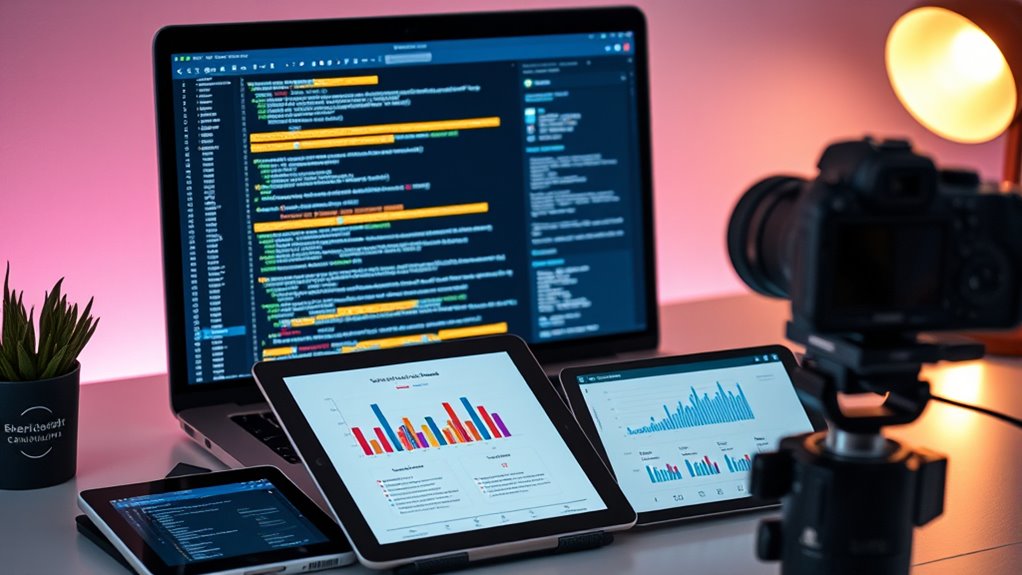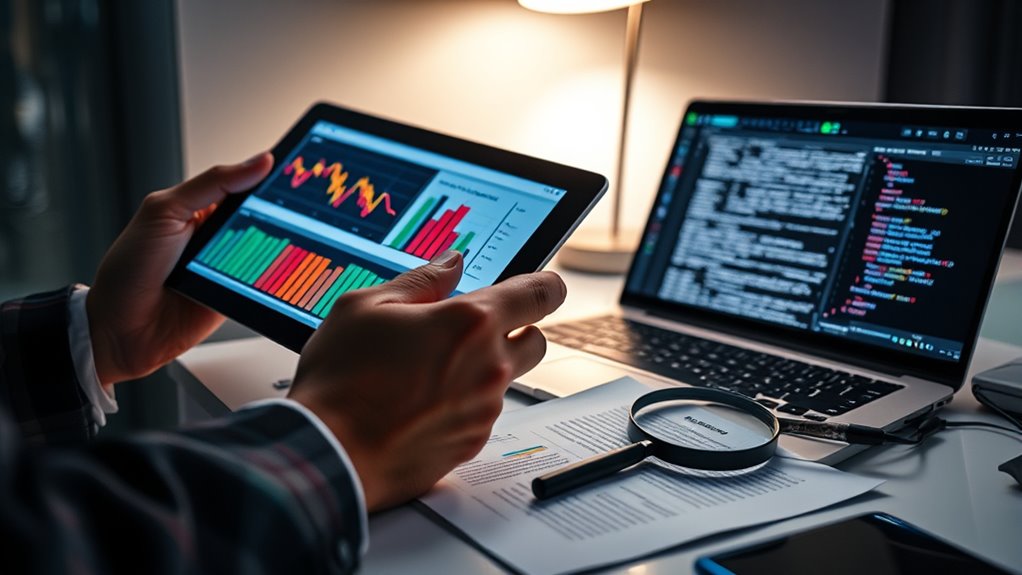To check plagiarism in data sections like a pro, start by using reputable detection tools that scan your content against published sources and online databases. Carefully review the highlighted similarities, ensuring they aren’t false positives, and cite sources correctly when needed. Incorporate these checks into your workflow before finalizing your work, and maintain meticulous records of your data sources. Staying vigilant and ethical protects your credibility—keep going to discover more tips on safeguarding your research’s integrity.
Key Takeaways
- Use reputable plagiarism detection tools specifically designed for data and numerical content.
- Incorporate the software into your workflow before finalizing reports to catch overlaps early.
- Review highlighted similarities carefully to distinguish false positives from genuine issues.
- Properly cite all data sources and maintain detailed documentation of your research process.
- Cross-verify data consistency and originality through multiple tools to ensure comprehensive checking.

Have you ever wondered how to guarantee the data sections in your research or report are original and free from plagiarism? Ensuring data integrity is critical, especially when your credibility depends on the accuracy and authenticity of your work. One of the most effective ways to achieve this is by leveraging plagiarism detection tools specifically designed for data verification. These tools help you identify any overlapping or duplicated content, whether it’s from published studies, online sources, or even previous drafts. By running your data sections through these tools, you can catch accidental or intentional copying early, giving you the chance to revise and uphold the integrity of your research.
Using plagiarism detection tools for data verification isn’t just about avoiding plagiarism; it’s about maintaining trustworthiness in your findings. Many of these tools scan vast databases and cross-reference your data against published material, highlighting any similarities that might raise concerns. This process ensures your data is uniquely yours and that you’re not unintentionally copying someone else’s work. It also helps in verifying that your data interpretation and presentation are original, which is crucial for the credibility of your research. When the data sections are verified for originality, it reassures readers, reviewers, and stakeholders that your work stands on a solid foundation of integrity.
To effectively check for plagiarism in your data, you should incorporate these tools into your standard research workflow. Before finalizing your report, run your data sections through reputable plagiarism detection software. Take the time to review the highlighted similarities carefully; sometimes, common phrases or standard methodological descriptions may trigger false positives. Adjust your content accordingly to eliminate any problematic overlaps. Remember, the goal isn’t just to pass a check but to genuinely verify that your data and its presentation are authentic. Additionally, understanding the importance of color accuracy in data presentation can help ensure your visual data is both truthful and compelling.
Along with using detection tools, focus on good data management practices. Properly cite sources, document your data collection and analysis methods, and keep detailed records of your work process. These habits support data integrity verification and make it easier to demonstrate originality if questions arise. In the digital age, maintaining originality in your data sections isn’t optional—it’s essential. By proactively employing plagiarism detection tools and adhering to rigorous data management, you position yourself as a credible researcher committed to ethical standards. Ultimately, these steps help you produce work that’s not only accurate but also trustworthy and respected in your field.
Frequently Asked Questions
How Can I Verify Data Originality Without Access to Original Sources?
When you need to verify data originality without access to original sources, focus on data verification techniques. Use specialized tools like plagiarism checkers or statistical analysis software to detect inconsistencies or duplicated patterns. Conduct a thorough originality assessment by comparing the data with existing datasets or published research. These steps help guarantee the integrity of your data and confirm its authenticity, even when original sources aren’t available.
What Are Common Signs of Data Plagiarism in Research Papers?
Have you ever wondered if data in a paper is genuinely original? Look for signs like inconsistent data points or sudden shifts in data trends that don’t align. Graph anomalies, such as unexpected spikes or irregular patterns, can indicate manipulation. Check for data inconsistency across sections and verify if data presentation matches the context. These clues can reveal whether the data stands on its own or might be plagiarized.
Which Tools Are Best for Detecting Data Duplication?
When it comes to detecting data duplication, you want tools that excel in data analysis and guarantee citation integrity. Popular options include Turnitin and iThenticate, which scan for similarities across datasets and documents. Additionally, software like SafeAssign and PlagScan can help verify originality in research data. These tools let you quickly identify duplicate or manipulated data, maintaining the integrity of your research and ensuring accurate, plagiarism-free results.
How Do I Handle Suspected Data Plagiarism Ethically?
Handling suspected data plagiarism isn’t just a minor issue; it’s a battle for research integrity itself! First, you document everything meticulously, then conduct an ethical investigation, respecting confidentiality and fairness. Reach out to the accused for clarification, and follow institutional protocols. Upholding honesty and transparency is essential to maintain trust. Remember, your actions should promote integrity, ensuring the research community stays strong and credible against any allegations of misconduct.
Can Plagiarism Detection Software Identify Manipulated or Altered Data?
When you ask if plagiarism detection software can spot manipulated or altered data, it’s important to know that while these tools excel at identifying textual plagiarism, they often struggle with data manipulation. They may detect statistical inconsistencies or anomalies that suggest data tampering, but subtle manipulations can go unnoticed. Thus, you should complement software checks with careful manual review to guarantee data integrity and catch any subtle alterations or manipulations.
Conclusion
Think of checking data sections like a detective unraveling a mystery—you have to follow every lead to guarantee authenticity. I once caught a subtle plagiarism hint that was like a misplaced puzzle piece, transforming the entire picture. Remember, thorough scrutiny isn’t just about catching dishonesty; it’s about safeguarding your credibility. When you approach data with precision and diligence, you become the expert who turns chaos into clarity, proving that even the tiniest detail matters.










